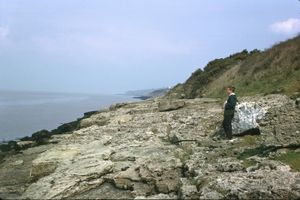Raised beach deposits, Quaternary, Bristol and Gloucester region
| Green, G W. 1992. British regional geology: Bristol and Gloucester region (Third edition). (London: HMSO for the British Geological Survey.) |
Raised beach deposits

A locally extensive wave-cut platform at about present sea level occurs at intervals around the present coast. At Brean Down, for instance, the Howe Rock platform, cut in Carboniferous Limestone, surrounds much of the headland and passes beneath late Devensian breccias with an arctic fauna. The inner edge of the platform lies at about OD and the outer edge is more than 6 m below OD. The width of the platform here and elsewhere is such that it seems likely that completion of its cutting may have occupied more than one period of low sea level in Devensian or possibly even earlier times.
Raised beach deposits, and an associated wave-cut platform ranging in height from 9 to 14 m above OD, are present at intervals around the coast between Portishead and Brean Down (P006746), and inland at Weston-in-Gordano and Bleadon. The beach material contains a temperate mollusc fauna shown by AAR tests for Middle Hope, Weston-super-Mare, to be mainly of Ipswichian age but possibly incorporating somewhat older material (Oxygen Isotope Stage 7). These beach deposits are usually covered with Devensian breccia and solifluction deposits, which may include an Arctic fauna. In the Weston-super-Mare area, colluvial deposits with both cold and warm aspects may intervene between the Ipswichian deposits and the platform. Furthermore, at Holly Lane, Clevedon, quarrying has exposed, beneath Devensian breccias and loams, a wave-cut notch at about 20 m above OD at the junction of a wave-cut platform and an old cliff face. The latter may be correlated with an erosion bench backed by an ancient cliff line in the western Mendips with a base at about 21 m OD.
These various features indicate a complex sequence of events with perhaps three episodes of high sea level, but no agreement exists on the dating of the earlier episodes except that they predate the Devensian glaciation and hence a date earlier than Hoxnian is unlikely.
Burtle Beds In the vicinity of Middlezoy, and elsewhere in the Somerset Levels, there occurs a series of shelly sands and gravels, known as the Burtle Beds, which are generally considered to represent littoral or sublittoral deposits formed during a period of high sea level. The fossils include common and widely distributed temperate marine shells and, more rarely, the brackish-freshwater Corbiculafluminalis. Bones and teeth of elephant, rhinoceros, aurochs and other mammals have also been found and are presumed to have been washed in from the surrounding land areas. Although the bulk of the material is Ipswichian on AAR results, some reworking has occurred because both pre-Ipswichian and Flandrian dates have been locally obtained. Similar deposits have been discovered at Kenn Moor, between Clevedon and Yatton, where they overlie till of presumed Anglian age.